Never miss another geomagnetic storm. Sign up for Space Weather Alerts and you'll receive a text message when magnetic storms erupt. Aurora tour guides and professional astronomers use this service. You can, too! | | |
A CME MIGHT HIT EARTH THIS WEEK: NOAA forecasters say that G1-class geomagnetic storms are likely on Dec. 27th when a CME is expected to hit Earth's magnetic field. The CME left the sun on Christmas Eve, propelled by the explosion of a magnetic filament: movie. Arctic sky watchers should be alert for auroras tomorrow night. Aurora alerts: SMS Text.
HAARP IS ABOUT TO PING AN ASTEROID: Researchers from NASA and the University of Alaska are about to perform an unusual radar experiment. They're going to ping a near-Earth asteroid using shortwave radio. The target is a 500-ft-wide space rock named "2010 XC15." When it passes by Earth on Tuesday, Dec. 27th, the HAARP array in Alaska will hit it with a pulse of 9.6 MHz radio waves.
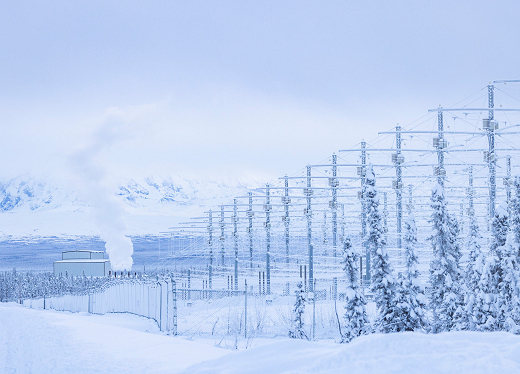
The High-frequency Active Auroral Research Program (HAARP) site in Gakona, Alaska
Radio astronomers ping asteroids all the time. What's unusual about this experiment is the frequency: 9.6 MHz is hundreds of times lower than typical S-band and X-band frequencies used by other asteroid radars. The goal is to probe the asteroid's interior.
Lead investigator Mark Haynes of the Jet Propulsion Laboratory (JPL) explains: "The low frequencies we are using can penetrate the asteroid, unlike S-band or X-band frequencies which reflect mostly off of the surface. Ultimately the idea is to use echoes to form tomographic images of asteroid interiors."
Knowing the internal structure of an asteroid could come in handy -- especially if you need to destroy it. 2010 XC15 poses no threat 770,000 km from Earth. Tomorrow's experiment is proof-of-concept for a scarier object: Asteroid Apophis, which will buzz Earth closer than many satellites on April 13, 2029. If shortwave asteroid radar works for 2010 XC15, it should work for Apophis, too, giving planetary defense experts key data about the asteroid's vulnerabilities.
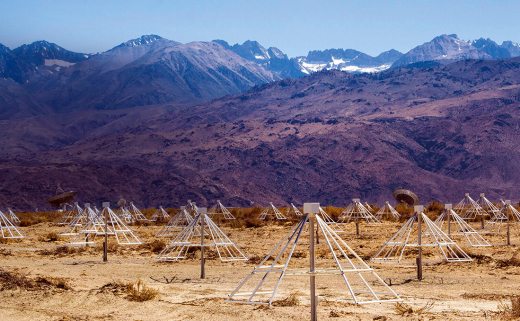
The OVRO Long Wavelength Array near Bishop, CA, will receive echoes from HAARP's transmission
HAARP will transmit a continually chirping signal to asteroid 2010 XC15 at slightly above and below 9.6 MHz. The chirp will repeat at two-second intervals. The University of New Mexico Long Wavelength Array near Socorro, NM, and the Owens Valley Radio Observatory Long Wavelength Array near Bishop, CA, will receive the reflected signal.
"This will be the lowest frequency asteroid radar observation ever attempted," notes Lance Benner, a co-investigator from JPL. If the experiment works it could mark a significant advance in asteroid radar. Stay tuned!
Realtime Space Weather Photo Gallery
Free: Spaceweather.com Newsletter
CRYOVOLCANIC COMET OCCULTATION: For the second time this month, Comet 29P is about to occult a relatively bright star, giving astronomers an opportunity to trace the shape of this strange cryovolcanic comet. The shadow track on Dec. 27th cuts across many populated areas in the western USA:

"This event may prove to be the best this decade, so observers please do try and cover it," urges Dr. Richard Miles of the British Astronomical Association, a leading researcher of Comet 29P. "A video record is required, preferably with absolute timing and frame exposure times of 0.25 sec or less."
The star is 13th magnitude, and it is expected to wink out when it passes behind the comet's core at approximately 12:20 UT or 4:20 am PST on Tuesday morning. The weather forecast favors observers in the southern half of the track--especially Arizona, New Mexico and Texas.
For local predictions and more information, check the MISSION 29P website.
Realtime Space Weather Photo Gallery
Free: Spaceweather.com Newsletter
AMBER BUMBLEBEE SPACE PENDANT: Bumblebees don't usually fly so high. On Oct 15, 2022, the students of Earth to Sky Calculus launched this one to the stratosphere onboard a cosmic ray research balloon. Here it is floating 115,158 feet above California's Sierra Nevada:
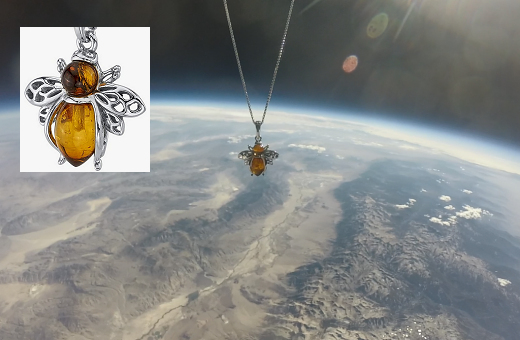
You can have it for $179.95. This bee is made of genuine Baltic Amber with a sterling silver exoskeleton. The rich Cognac-colored pendant measures 3/4 inch and comes with a matching 18-inch sterling silver chain.
The students are selling these unique pendants to support their cosmic ray ballooning program. Each one comes with a greeting card showing the bumblebee in flight and telling the story of its trip to the stratosphere and back again.
Far Out Gifts: Earth to Sky Store
All sales support hands-on STEM education
Realtime Aurora Photo Gallery
Free: Spaceweather.com Newsletter
Every night, a network of
NASA all-sky cameras scans the skies above the United States for meteoritic fireballs. Automated software maintained by NASA's Meteoroid Environment Office calculates their orbits, velocity, penetration depth in Earth's atmosphere and many other characteristics. Daily results are presented here on Spaceweather.com.
On Dec 26, 2022, the network reported 10 fireballs.
(8 sporadics, 2 December Leonis Minorids)
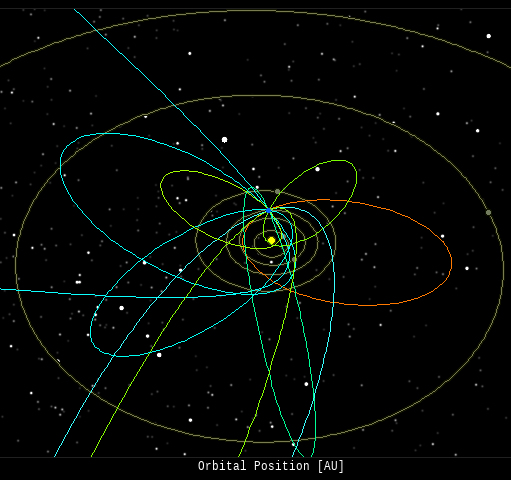
In this diagram of the inner solar system, all of the fireball orbits intersect at a single point--Earth. The orbits are color-coded by velocity, from slow (red) to fast (blue). [Larger image] [movies]
Potentially Hazardous Asteroids (
PHAs) are space rocks larger than approximately 100m that can come closer to Earth than 0.05 AU. None of the known PHAs is on a collision course with our planet, although astronomers are finding
new ones all the time.
On December 26, 2022 there were 2321 potentially hazardous asteroids.
 |
Recent & Upcoming Earth-asteroid encounters: | Asteroid | Date(UT) | Miss Distance | Velocity (km/s) | Diameter (m) |
| 2022 YE2 | 2022-Dec-21 | 13.9 LD | 17.3 | 53 |
| 2017 XQ60 | 2022-Dec-21 | 18.8 LD | 16 | 45 |
| 2022 YJ5 | 2022-Dec-21 | 6.2 LD | 18.6 | 16 |
| 2022 YK | 2022-Dec-22 | 3.2 LD | 2.8 | 7 |
| 2022 YG | 2022-Dec-22 | 6.4 LD | 5.5 | 17 |
| 2022 UD9 | 2022-Dec-22 | 4.6 LD | 10.3 | 159 |
| 2022 YG2 | 2022-Dec-22 | 1 LD | 6.4 | 6 |
| 2022 RD2 | 2022-Dec-22 | 13.9 LD | 1.1 | 7 |
| 2022 YC4 | 2022-Dec-23 | 1.7 LD | 17.5 | 9 |
| 2022 YN | 2022-Dec-23 | 20 LD | 6.8 | 25 |
| 2022 YB | 2022-Dec-23 | 10.3 LD | 5.8 | 27 |
| 2022 YJ3 | 2022-Dec-23 | 12.5 LD | 6.7 | 12 |
| 2022 YO | 2022-Dec-24 | 3.5 LD | 9.3 | 13 |
| 2022 YY4 | 2022-Dec-24 | 18.2 LD | 8 | 21 |
| 2018 YK2 | 2022-Dec-24 | 9.8 LD | 14.7 | 98 |
| 2022 YZ4 | 2022-Dec-24 | 16.4 LD | 12.4 | 20 |
| 2022 XN | 2022-Dec-24 | 8.5 LD | 11 | 47 |
| 2022 YX2 | 2022-Dec-24 | 0.6 LD | 11.3 | 7 |
| 2022 XM1 | 2022-Dec-24 | 9.7 LD | 12.7 | 31 |
| 2022 YL1 | 2022-Dec-25 | 7.7 LD | 12.2 | 50 |
| 2022 YK3 | 2022-Dec-25 | 1.6 LD | 12.8 | 5 |
| 2022 YY1 | 2022-Dec-25 | 5.2 LD | 14.7 | 22 |
| 2013 YA14 | 2022-Dec-25 | 2.7 LD | 10.5 | 68 |
| 2022 TE14 | 2022-Dec-25 | 11.2 LD | 7 | 127 |
| 2022 YB1 | 2022-Dec-26 | 5.7 LD | 14.8 | 26 |
| 2022 YH5 | 2022-Dec-26 | 9.1 LD | 15.7 | 18 |
| 2019 LT5 | 2022-Dec-27 | 16.2 LD | 15 | 118 |
| 2022 YY3 | 2022-Dec-27 | 2.6 LD | 8.5 | 10 |
| 2022 YR4 | 2022-Dec-27 | 0.8 LD | 7.7 | 6 |
| 2022 YG1 | 2022-Dec-27 | 11.3 LD | 16.2 | 28 |
| 2022 WV9 | 2022-Dec-27 | 6.5 LD | 7.2 | 46 |
| 2010 XC15 | 2022-Dec-27 | 2 LD | 10.1 | 182 |
| 2022 XL1 | 2022-Dec-27 | 7.6 LD | 8.4 | 28 |
| 2022 YL | 2022-Dec-27 | 7.9 LD | 5.6 | 18 |
| 2021 AE | 2022-Dec-28 | 16.5 LD | 15 | 23 |
| 2022 YG5 | 2022-Dec-30 | 8.2 LD | 14.2 | 16 |
| 2022 YR1 | 2023-Jan-01 | 16.3 LD | 6 | 21 |
| 2022 YT3 | 2023-Jan-02 | 11.1 LD | 6.4 | 26 |
| 2022 YU3 | 2023-Jan-02 | 9.9 LD | 7.1 | 24 |
| 2021 NF | 2023-Jan-02 | 17.9 LD | 11.3 | 40 |
| 2022 YJ4 | 2023-Jan-03 | 5.3 LD | 5.6 | 15 |
| 2011 WR41 | 2023-Jan-03 | 15.8 LD | 8.9 | 34 |
| 2019 AY3 | 2023-Jan-04 | 16.8 LD | 19.7 | 62 |
| 2022 YS4 | 2023-Jan-04 | 6 LD | 6.8 | 28 |
| 2022 YL4 | 2023-Jan-05 | 5.2 LD | 2 | 11 |
| 2022 YN1 | 2023-Jan-06 | 18.3 LD | 5.5 | 54 |
| 2021 TL | 2023-Jan-09 | 14.2 LD | 8.5 | 75 |
| 2022 YD5 | 2023-Jan-12 | 8.4 LD | 10.8 | 45 |
| 2022 YZ2 | 2023-Jan-12 | 16.7 LD | 6.5 | 92 |
| 2014 LJ | 2023-Jan-14 | 4.8 LD | 3.5 | 7 |
| 2022 YH3 | 2023-Jan-14 | 19 LD | 16.3 | 91 |
| 2012 BV13 | 2023-Jan-16 | 12.2 LD | 6.7 | 134 |
| 2020 BP | 2023-Jan-20 | 5.2 LD | 16.9 | 26 |
| 2019 BO2 | 2023-Jan-24 | 12.1 LD | 16.2 | 21 |
| 2019 BZ4 | 2023-Jan-24 | 16.5 LD | 5.6 | 20 |
| 2020 BZ14 | 2023-Jan-26 | 8.8 LD | 6.7 | 54 |
| 2022 SO113 | 2023-Jan-29 | 10.5 LD | 3.5 | 73 |
| 2017 DU34 | 2023-Feb-02 | 13.3 LD | 11.2 | 16 |
| 367789 | 2023-Feb-03 | 4.7 LD | 9.9 | 149 |
| 2020 OO1 | 2023-Feb-04 | 4.8 LD | 7.7 | 19 |
| 2022 CX1 | 2023-Feb-09 | 17.4 LD | 13.2 | 14 |
| 2021 EP4 | 2023-Feb-13 | 19 LD | 6.1 | 5 |
| 199145 | 2023-Feb-16 | 12 LD | 24.6 | 756 |
| 2022 RG | 2023-Feb-16 | 8.2 LD | 3 | 24 |
| 2020 DG4 | 2023-Feb-17 | 1.4 LD | 6.9 | 8 |
| 2020 CX1 | 2023-Feb-19 | 17.4 LD | 7.7 | 53 |
| 37638 | 2023-Feb-21 | 17 LD | 11.1 | 495 |
Notes: LD means "Lunar Distance." 1 LD = 384,401 km, the distance between Earth and the Moon. 1 LD also equals 0.00256 AU. | | Cosmic Rays in the Atmosphere |
SPACE WEATHER BALLOON DATA: Almost once a week, Spaceweather.com and the students of Earth to Sky Calculus fly space weather balloons to the stratosphere over California. These balloons are equipped with sensors that detect secondary cosmic rays, a form of radiation from space that can penetrate all the way down to Earth's surface. Our monitoring program has been underway without interruption for 7 years, resulting in a unique dataset of in situ atmospheric measurements.
Latest results (July 2022): Atmospheric radiation is decreasing in 2022. Our latest measurements in July 2022 registered a 6-year low:
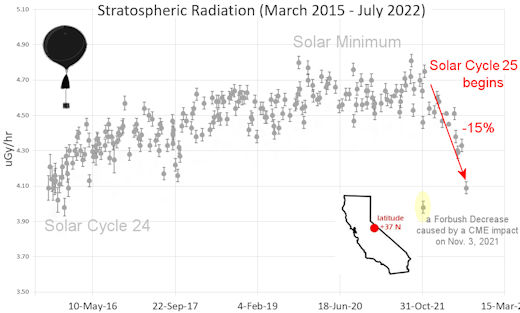
What's going on? Ironically, the radiation drop is caused by increasing solar activity. Solar Cycle 25 has roared to life faster than forecasters expected. The sun's strengthening and increasingly tangled magnetic field repels cosmic rays from deep space. In addition, solar coronal mass ejections (CMEs) sweep aside cosmic rays, causing sharp reductions called "Forbush Decreases." The two effects blend together to bring daily radiation levels down.
.Who cares? Cosmic rays are a surprisingly "down to Earth" form of space weather. They can alter the chemistry of the atmosphere, trigger lightning, and penetrate commercial airplanes. According to a study from the Harvard T.H. Chan school of public health, crews of aircraft have higher rates of cancer than the general population. The researchers listed cosmic rays, irregular sleep habits, and chemical contaminants as leading risk factors. A number of controversial studies (#1, #2, #3, #4) go even further, linking cosmic rays with cardiac arrhythmias and sudden cardiac death.
Technical notes: The radiation sensors onboard our helium balloons detect X-rays and gamma-rays in the energy range 10 keV to 20 MeV. These energies span the range of medical X-ray machines and airport security scanners.
Data points in the graph labeled "Stratospheric Radiation" correspond to the peak of the Regener-Pfotzer maximum, which lies about 67,000 feet above central California. When cosmic rays crash into Earth's atmosphere, they produce a spray of secondary particles that is most intense at the entrance to the stratosphere. Physicists Eric Regener and Georg Pfotzer discovered the maximum using balloons in the 1930s and it is what we are measuring today.
| | The official U.S. government space weather bureau |
| | The first place to look for information about sundogs, pillars, rainbows and related phenomena. |
| | Researchers call it a "Hubble for the sun." SDO is the most advanced solar observatory ever. |
| | 3D views of the sun from NASA's Solar and Terrestrial Relations Observatory |
| | Realtime and archival images of the Sun from SOHO. |
| | information about sunspots based on the latest NOAA/USAF Active Region Summary |
| | current counts of failed and deployed Starlink satellites from Jonathan's Space Page |
| | Authoritative predictions of space junk and satellite re-entries |
| | from the NOAA Space Environment Center |
| | fun to read, but should be taken with a grain of salt! Forecasts looking ahead more than a few days are often wrong. |
| | from the NOAA Space Environment Center |
| | the underlying science of space weather |
 | BestCSGOGambling is the best site for everything related to CSGO gambling on the web |
 | To find reviews of new online casino sites in the UK try The Casino DB where there are hundreds of online casino reviews complete with bonuses and ratings. Alternatively, Online-Casinos.xyz is another massive directory of online casinos listing sites for the UK and Worldwide. Casinos that offer Rupees for bonuses are very generous to Indian players. Find the best online casinos in India at AllCasinos.in Looking for a new online casino? Try Casimpo the new site dedicated to making online casino simple, or check out the new Avenger Slots Casino and Ace Online Casino with over 500 online slots and casino games. |
 | When looking for casinos to play online when the weather is bad, you can try casino online trucchi for Italian games. If you are not from Finland you can try the Swedish page Svenska casino online to find suitable games, check out svenskacasinoonline.net. Always check your local laws before playing with real money. |
 | Looking for sports betting companies not registered on GamStop? CasinoGap has presented a list of sites not on GamStop available for UK players. Check and bet online! Would you like to bet at sites not using GamStop? Look at a list of NonStopCasino sites for online betting that aren't on GamStop. Top-rated bookmakers ever! |
| | These links help Spaceweather.com stay online. Thank you to our supporters! |
| | | | | | |

